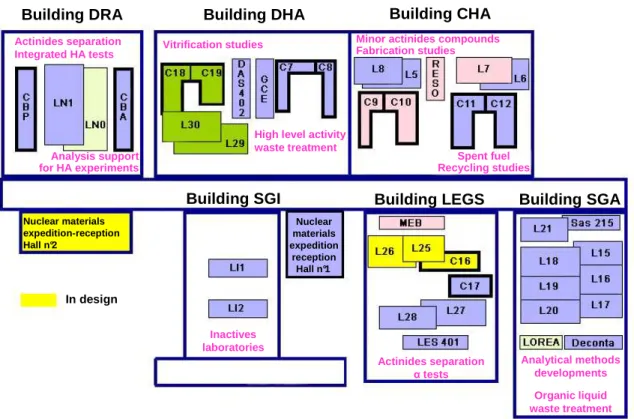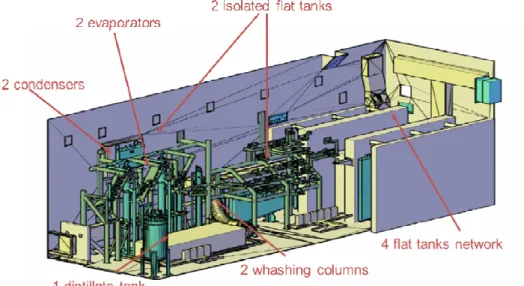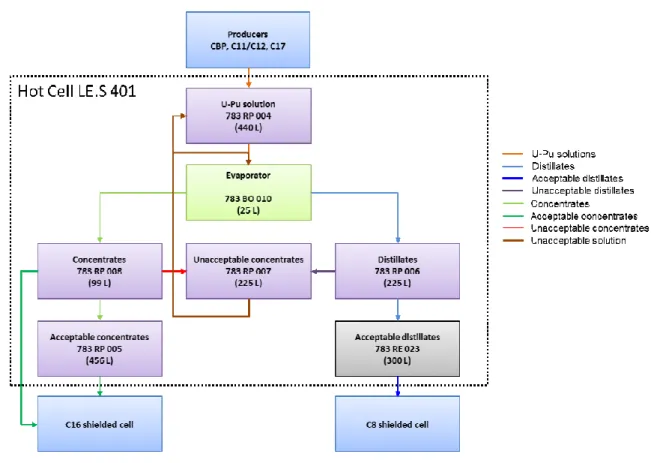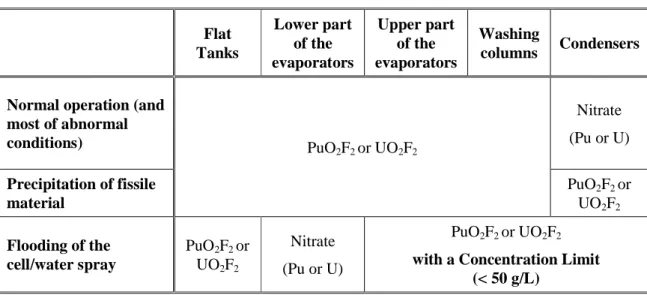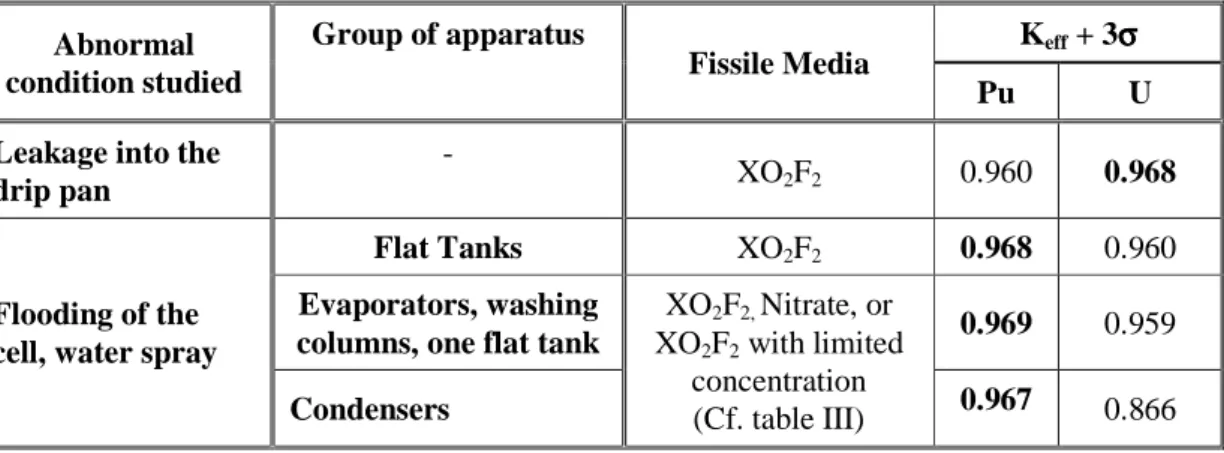HAL Id: cea-02492553
https://hal-cea.archives-ouvertes.fr/cea-02492553
Submitted on 27 Feb 2020HAL is a multi-disciplinary open access archive for the deposit and dissemination of sci-entific research documents, whether they are pub-lished or not. The documents may come from teaching and research institutions in France or abroad, or from public or private research centers.
L’archive ouverte pluridisciplinaire HAL, est destinée au dépôt et à la diffusion de documents scientifiques de niveau recherche, publiés ou non, émanant des établissements d’enseignement et de recherche français ou étrangers, des laboratoires publics ou privés.
Storage and concentration of plutonium and uranium
solutions in LES 401 hot cell (ATALANTE) - criticality
safety considerations
L. Cholvy, Pascale Giroud, A. Hervy, L. Athenour
To cite this version:
L. Cholvy, Pascale Giroud, A. Hervy, L. Athenour. Storage and concentration of plutonium and uranium solutions in LES 401 hot cell (ATALANTE) - criticality safety considerations. ICNC 2015 - International Cooperation in Nuclear Criticality Safety, Sep 2015, Charlotte, United States. �cea-02492553�
STORAGE AND CONCENTRATION OF PLUTONIUM AND URANIUM
SOLUTIONS IN LES 401 HOT CELL (ATALANTE) – CRITICALITY
SAFETY CONSIDERATIONS
Laurent CHOLVY, Philippe GIROUD, Antoine HERVY and Laurent ATHENOUR
CEA Centre de Marcoule
BP 17171 30207 Bagnols-sur-Cèze cedex
laurent.cholvy@cea.fr; philippe.giroud@cea.fr; antoine.hervy@cea.fr; laurent.athenour@cea.fr
ABSTRACT
ATALANTE is one of the main Nuclear Facilities of the French Alternative Energies and Atomic Energy Commission, located in Marcoule.
The hot cell LES 401 was built in the 1980’s and, since then, had been operated only with low masses of fissile material. As part of the optimizing of the management of the purified Uranium and Plutonium solutions (“Fin U Pu” Project), the new functions provided in LES 401 are now expected to be the following ones:
• Receiving Uranium and Plutonium solutions,
• Concentration of these solutions,
• Storage of the concentrates and distillates.
From the criticality safety point of view, the equipment was originally designed in safe geometry for Plutonium Nitrate, considering only a 2.5 cm-thick water reflector.
However, the new criticality safety case had to take into account the following points:
• Receiving Plutonium solutions, but also highly enriched Uranium solutions,
• Considering the flood risk as a possible contingency,
• Considering precipitation as a possible contingency.
These more conservative assumptions have led to introduce, in addition to the geometry control mode, a mass limit in the cell.
For the equipment containing very low concentrations of fissile material in normal operation, it was necessary, using the double contingency principle, to take into account a concentration limit, in the specific situation of water flooding of the cell.
At least, given the mass and geometry control mode, it was necessary to perform all the calculations with both fissile media (Plutonium and Uranium), as it was found that the most penalizing media is not always the same, depending on the selected mass, geometry, and reflection conditions.
KEYWORDS
Storage, concentration, solutions, criticality
1. INTRODUCTION
The hot cell LES 401 is located in the Atalante facility in Marcoule. It was built in the 1980’s, and designed in safe geometry, considering the safety standards of that era. However, since then, the cell had been operated only with low masses of fissile material, and the criticality control mode was only the limitation of the mass of fissile material.
As part of the optimizing of the management of the purified Uranium and Plutonium solutions of Atalante, new functions are now expected in LES 401, such as receiving and concentrating Uranium and Plutonium solutions. It is then necessary to operate the cell with a mass of fissile material higher than the safe mass, using the geometry of the vessels for the criticality safety case. This paper presents the challenges encountered when reconsidering, with new targets, and by today’s standards, the calculations and safety case of LES 401.
2. ATALANTE FACILITY
ATALANTE [1] is one of the main Nuclear Facilities of the French Alternative Energies and Atomic Energy Commission, located in Marcoule. This facility is mainly dedicated to the development and research of nuclear energy for the back end of the fuel cycle: spent fuel and ultimate waste management. The ATALANTE facility groups 18 hot labs and 11 shielded cells devoted to research and development on the fuel cycle. The activities represent four major sectors of nuclear research:
• supporting the operation of existing reprocessing plants, with the aim of adapting the head of the process to the increase of spent fuel burn-up and to different types of new burned fuels to be reprocessed (including MOX, USi or UMo fuels),
• further developing the COEX TM process,
• preparing the recycling of minor actinides (MA) by partitioning or by grouped actinide extraction, and by MA-bearing fuel fabrication,
• studying the long term behaviour of high level waste conditioning matrices, and especially the self-irradiation and leaching of vitrified waste.
Figure 1 ATALANTE - modular facility drawing.
Building DRA Building DHA Building CHA
Building SGI Building LEGS Building SGA
In design Actinides separation Integrated HA tests Analysis support for HA experiments Vitrification studies
High level activity waste treatment
Minor actinides compounds Fabrication studies Spent fuel Recycling studies Inactives laboratories Actinides separation αtests Analytical methods developments Organic liquid waste treatment Nuclear materials expedition-reception Hall n°2 Nuclear materials expedition reception Hall n°1
In terms of criticality risk prevention, the facility is divided into work units (more than 25) which are mostly managed through a mass control mode. Some units, like the fuel reception cells or the nuclear material storage rooms, are managed by a mass + geometry control mode. The limit authorized for the mass-limited work units is 350 g of fissile material, with the main materials taken into account being
239
Pu, 235U with enrichment higher than 1%, and 233U.
Detection and monitoring for a criticality situation are ensured by nine units of a Criticality Accident Alarm System (CAAS) set up in the facility [2].
3. THE HOT CELL LES 401 3.1. Presentation
The hot cell LES 401 is located in the building LEGS in the Atalante facility. The cell is 12 m length, 4 m width and 4 m height with 50 cm concrete walls covered by an inox steel skin. The cell contains several pieces of equipment (six flat tanks, two evaporators, two condensers and two washing columns) and a high density pipes and valves network.
The cell is divided in two main areas, one for the process and one for the storage. In the storage network of flat tanks, the tanks are separated by borated concrete blocks.
3.2. Operating process
The plutonium and uranium solutions generated in Atalante by R&D activities come mainly from the shielded lines where they were submitted to an initial purification cycle (PUREX process). Those solutions are stored in a flat tank then go thru the evaporator and generate the concentrates and the distillates which are collected in separated tanks. The concentrates will be sent to the future cell C16, the next step of the process in order to transform the U-Pu solution into oxide. [3]
3.3. Equipment’s characteristics
Table I presents the main characteristics of the equipment according to the criticality safety.
Table I. Main limit data for equipment for criticality safety
Limit data eint or Øint
Flat tanks eint ≤ 7,5 cm
Washing columns Øint ≤ 14,13 cm
Condensers Øint ≤ 16,87 cm
Evaporators Upper cylinder Øint ≤ 16,83 cm
Lower cylinder Øint ≤ 14,13 cm
3.4. Renovation of the cell LES 401
The hot cell LES 401 has been operated from the 1990’s. Thanks to the rinsing done before the renovation, the level of irradiation is lower than 2.5 10-3 mSv/h. However there is still a risk of
contamination so the interventions have to be done wearing ventilated dress. Operating conditions and the
high contention of the cell makes the works very complex and required a high level of studies and preparation. Hundreds of interventions have been required to complete the renovation of the cell. The main vessels have been kept but a lot of new pipes and valves were settled in. Hundreds of welds were done and controlled by radiography.
4. SOME POINTS TO TAKE INTO ACCOUNT IN THE NEW CRITICALITY SAFETY CASE
The new criticality safety case had to take into account the following points:
• receiving Plutonium solutions, but also highly enriched Uranium solutions,
• considering the flood risk as a possible contingency,
• considering precipitation as a possible contingency.
4.1. Receiving Highly Enriched Uranium Solutions
The original calculations in LES 401 had been performed only for Plutonium Nitrate (100% 239Pu). In the new functions of the hot cell, it was decided that the reception of highly-enriched Uranium solutions should also be possible. Considering the initial reference fissile medium it was supposed that the presence of highly enriched Uranium (235U/Utotal > 90%) instead of Plutonium would not be significantly
penalizing. However, given the chosen criticality control mode, it was found afterwards that the most penalizing medium is not always the same (see § 6).
4.2. Considering the Flood Risk as a Possible Contingency
The original calculations in LES 401 had been performed with only a 2.5 cm-thick water reflector around the equipment. Considering the location of the cell (basement of LEGS building) and the fact that the drip pan of the cell was not drained by gravity, it was decided to take into account the flood risk as a possible contingency. This choice has implied taking into account (as an abnormal condition) a full water
reflection, or a variable water thickness around every piece of equipment, or a water mist (variable density) in the cell volume. This was by far the most penalizing among the new hypothesis chosen.
4.3. Considering Precipitation as a Possible Contingency
The original calculations in LES 401 had been performed with Plutonium Nitrate, moderated by water. The use of this reference fissile medium supposes that there is no risk of precipitation. However, some parts of the process (washing columns) used sodium hydroxide, which can cause Plutonium precipitation. Although the sodium hydroxide pipes were specific and separated from the other parts of the process (in particular those containing fissile material in normal operation) it was decided to take into account the precipitation hazard. The reference fissile media which have to be used then are PuO2F2 or UO2F2
(moderated by water), which are more penalizing than Nitrate.
4.4. Consequences of the New Hypothesis
Table II and Table III present some subcritical dimensions (calculated with CRISTAL V1) for various fissile media and reflection conditions.
Table II. Subcritical (Keff = 0.95) slab thicknesses for various fissile media and reflection conditions 239 Pu Nitrate Pu(NO3)3 HEU Uranyl Nitrate UO2(NO3)4 239 Pu Standard Salt 239 PuO2F2 HEU UO2F2 Flat tanks thickness in LES 401 2.5 cm-thick water reflector 8.79 cm 8.65 cm 8.21 cm 8.10 cm 7.5 cm Full water reflector (20 cm) 4.83 cm 4.85 cm 4.26 cm 4.19 cm
Table III. Subcritical (Keff = 0.95) cylinder diameter for various fissile media and reflection conditions 239 Pu Nitrate Pu(NO3)3 HEU Uranyl Nitrate UO2(NO3)4 239 Pu Standard Salt 239 PuO2F2 HEU UO2F2 Diameters of main cylindrical vessels in LES 401 2.5 cm-thick water reflector 17.8 cm 17.5 cm 17.0 cm 16.7 cm 14.13 cm 16.83 cm 16.87 cm Full water reflector (20 cm) 14.1 cm 14.0 cm 13.2 cm 13.1 cm
These results show that the presence of a full water reflector, but also, in some cases, the change of the reference fissile media, can lead to conclude that, if putting together all of the new pessimistic hypothesis, the existing equipment in LES 401 could not be considered as safe by design.
5. PRINCIPLES OF THE NEW CRITICALITY SAFETY CASE
As it was not possible, with the new hypothesis, to demonstrate that the existing apparatus was still favorable geometry equipment, several solutions have been studied:
• install new neutron absorbers (such as borated steel) as close as possible to the flat tanks,
• use less pessimistic isotopic compositions in the reference fissile media for Plutonium (at least 17 %
240
Pu) and Uranium (Intermediate Enriched Uranium),
• combining the geometry of the equipment with a mass limit, using a mass + geometry control mode. The first solution (install new neutron absorbers) was very difficult to realize on a technical point of view, as the preliminary calculations showed that the borated steel had to be very close from the tank on its entire surface. Furthermore, it could solve the problem only for the flat tanks.
The second solution (less pessimistic isotopic compositions) was possible, but induced limitations on the entry of the cell that seemed too restrictive to the operator. Moreover, regarding criticality safety, this
solution induced an additional risk of non- compliance with the reference fissile media, as this kind of limitation does not exist in the other parts of the facility.
The solution of the limitation of both mass and geometry was eventually chosen. Indeed, preliminary calculations showed that, given the geometry of the apparatus, the safe mass limit would be several kilograms of fissile material (Plutonium + 235U contained in Uranium whose enrichment is higher than 1%). This mass limit is not supposed to be binding, given the expected operating conditions.
5.1. Criticality Safety Case in Normal Operation
In normal operation:
• the criticality safety control mode is Mass + Geometry + Neutron Poison (borated concrete),
• the reference fissile media are 239PuO2F2-H2O and UO2F2(HEU)-H2O for all the vessels, except for
the two condensers (see below),
• the reflection around the equipment is limited (≤ 2.5 cm of water), as a flooding of the cell has not to be considered in normal operation,
• the criticality safety criteria is Keff + 3σ ≤ 0.95.
The permissible mass limit of fissile material applies to the whole criticality unit (all the vessels in the cell, except from the unfavorable geometry distillate tank 783 RE 023).
In those conditions, calculations were performed considering:
• in every flat tank, a cylinder of moderated fissile material, containing the whole permissible mass. The height of the cylinder is equal to the thickness of the tank. The diameter of the cylinder varies with the moderation ratio,
• in every cylindrical tank, a cylinder of moderated fissile material, containing the whole permissible mass. The diameter of the cylinder is equal to the diameter of the tank. The height of the cylinder varies with the moderation ratio.
This approach is conservative, as it was considered that each of the apparatus can hold (in the same time) all of the permissible mass of the unit.
Only the condensers (two apparatus with a large diameter, set up close to each other) needed a specific case. It has been necessary to consider that, for the condensers:
• in normal operation the reference fissile medium is Nitrate instead of PuO2F2 / UO2F2,
• the mass limit is divided into the two condenser, and not present simultaneously in both of them.
5.2. Criticality Safety Case in Abnormal Conditions
In abnormal conditions:
• the criticality safety control mode is Mass + Geometry + Neutron Poison; In one case, a concentration limit is also necessary (see table IV),
• the reference fissile media are 239PuO2F2-H2O and UO2F2(HEU)-H2O, except for two situations
where it is necessary to use Nitrate (see Table IV),
• the criticality safety criteria is Keff + 3σ ≤ 0.97.
Some hypotheses of the safety case, concerning mainly the reference fissile media, are presented in Table IV.
Table IV. Hypotheses (fissile media) depending on the conditions and the apparatus Flat Tanks Lower part of the evaporators Upper part of the evaporators Washing columns Condensers
Normal operation (and most of abnormal conditions) PuO2F2 or UO2F2 Nitrate (Pu or U) Precipitation of fissile material PuO2F2 or UO2F2 Flooding of the cell/water spray PuO2F2 or UO2F2 Nitrate (Pu or U) PuO2F2 or UO2F2
with a Concentration Limit (< 50 g/L)
Different abnormal conditions have been identified and studied in the safety case, such as:
• Mass Overload,
• Solutions coming out of favorable geometry (up to reagents alimentation, vacuum lines, etc…),
• Leakage of solutions down to the drip pan or into some jackets,
• Fire, corrosion, explosion, handling mistake, earthquake…,
• Precipitation,
• Change in the reflection conditions (Flooding of the cell/Water spray).
The precipitation hazard was already taken into account by the calculations made in normal operation (XO2F2 media), for all the vessels except the condensers. For the condensers, the replacement of Nitrate
by XO2F2, to take precipitation into account, leaded to an acceptable reactivity for abnormal conditions.
5.2.1. Special focus on the change in the reflection conditions
This situation includes the flood risk, but also the water spray, and every abnormal situation where the reflection conditions by water can be more penalizing than those adopted in normal operation (2.5 cm-thick water reflector).
For this situation, the devices had to be divided into two categories:
• Equipment containing highly concentrated fissile material in normal operation (flat tanks, lower part of the evaporators),
• Equipment containing very low concentrations of fissile material in normal operation (upper part of the evaporators, washing columns, condensers).
For the flat tanks, except from the reflection conditions, the hypothesis of the calculations remained the same as in normal operation. For the lower part of the condensers, to meet the criteria, it was necessary, in the specific situation of water flooding, to considerer that the reference fissile media was Nitrate instead of PuO2F2/UO2F2.
For the second category of devices (upper part of the evaporators, condensers, washing columns,), it was necessary, in this specific situation, to take into account a concentration limit of 50 grams of fissile material per liter. A concentration exceeding this limit can be considered unlikely because:
• during the normal operation of the process, these apparatus normally receive only vapors/distillates with no significant quantities of fissile material, and this normal operation is monitored (level and temperature measurements),
• even in the lower part of the evaporator, which contains highly concentrated fissile material, the concentration is limited under 50 grams of fissile material per liter.
Concerning a water flooding or aspersion in the cell, which would be detected by the liquid presence sensor in the drip pan, it has also been concluded that it could be considered as unlikely.
The double contingency principle, as declined in the French regulation [4], is similar as in international standards and in other countries’ regulations: at least two unlikely, independent and concurrent changes in process conditions are required before a criticality accident is possible. In our case, this principle allowed not to take into account the situation where we would have in the same time more than 50 g/L of fissile material in the distillates apparatus, and a flooding in the cell.
6. RESULTS AND COMMENTS ON THE REFERENCE FISSILE MEDIA
Some of the main results of the performed calculations are presented in tables V and VI.
Table V. Results in normal operation (criticality safety criteria: Keff + 3σσσσ ≤ 0.95)
Group of apparatus Fissile Media
Keff + 3σσσσ
Pu U
Flat tanks XO2F2 0.888 0.875
Evaporators, washing
columns, one flat tank XO2F2 0.936 0.949
Condensers Nitrate 0.944 0.934
Table VI. Results in some abnormal conditions (criticality safety criteria: Keff + 3σσσσ ≤ 0.97)
Abnormal condition studied
Group of apparatus
Fissile Media Keff + 3σσσσ Pu U Leakage into the
drip pan
-
XO2F2 0.960 0.968
Flooding of the cell, water spray
Flat Tanks XO2F2 0.968 0.960
Evaporators, washing columns, one flat tank
XO2F2, Nitrate, or XO2F2 with limited concentration (Cf. table III) 0.969 0.959 Condensers 0.967 0.866
The calculations have also shown that the interactions between the different groups of apparatus indicated above are negligible (the reactivity of the cell is always the one of the most reactive group).
One important point is that, given the mass + geometry control mode, it has been necessary to perform all the calculations with both fissile media (Plutonium and Uranium), as it was found that the most
penalizing media is not always the same. Indeed, we can notice that:
• when using only a mass control mode, the most penalizing media is Plutonium, as the minimal critical mass for 239Pu is lower than for 235U,
• when using only a geometry control mode, the subcritical dimensions are very close to each other. It is possible to compare subcritical dimensions for HEU versus 239Pu, for similar chemical forms, the same Keff and the same reflection conditions. For instance, the results in Table II and Table III,
presented above, could lead to the conclusion that HEU is slightly more penalizing than 239Pu, but this can also depend on the calculation code used and on the precise enrichment of Uranium.
When combining mass + geometry the hierarchy between the two isotopes appears not to be obvious and can depend on:
• the select mass limit (for example, a case with a very high mass limit will be close to a “geometry only” control mode),
• the type of geometry (flat, cylindrical) and the geometry limits,
• the selected reflection conditions (2.5 cm thick water reflector, or full water reflection).
7. CONCLUSIONS
In summary, this paper has presented some of the issues which can be encountered when building a new criticality safety case, with new operating targets, for an existing workshop. One example of the use of the double contingency principle has been shown in the case of a flooding of the cell. At least, this paper has also highlighted the fact that, when using a mass + geometry control mode in a unit which can receive both Plutonium and Highly Enriched Uranium, the definition of the reference fissile media is not obvious. Unless finding a specific demonstration, the calculations should be performed with both fissile media.
ACKNOWLEDGMENTS
The authors would like to acknowledge Areva RMC company, which performed the calculations related to LES 401, and CEA/DM2S/SERMA/CP2C, which provided the subcritical dimensions calculations.
REFERENCES
1. G. Bordier and Al, “The hot lab Atalante facility at CEA/Marcoule : towards GenIV systems fuel cycle”, ATALANTE 2008 – Montpellier (France) – May 19-22 2008,
2. P. Giroud and Al, “Practical study of a criticality accident alarm system implementation in Atalante”,
ICNC 2011 – Edinburgh (Scotland) – September 19-23 2011,
3. H. Lagrave and Al, “Treatment of Uranium and Plutonium solutions generated in Atalante by R&D activities”, ATALANTE 2008 – Montpellier (France) – May 19-22 2008,
4. ASN resolution number 2014-DC-0462 concerning the control of criticality risk in basic nuclear installations- October 7 2014.
